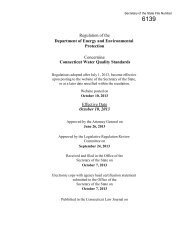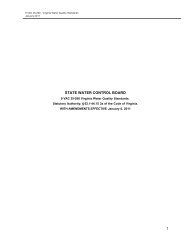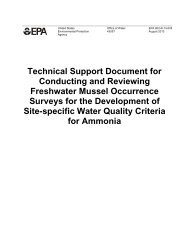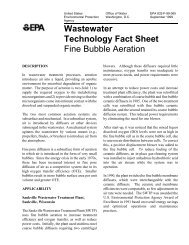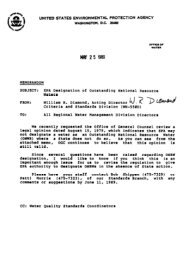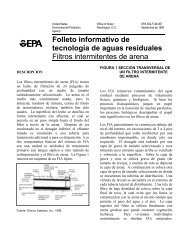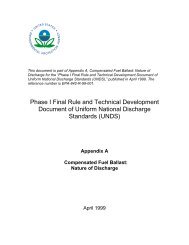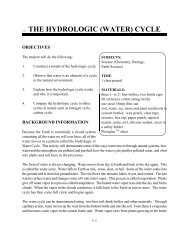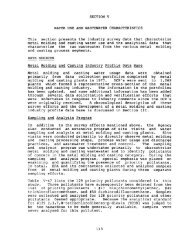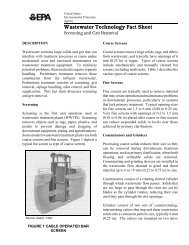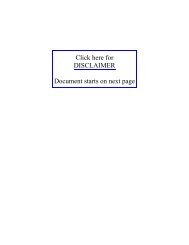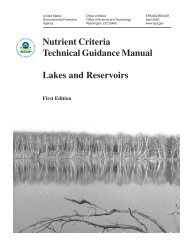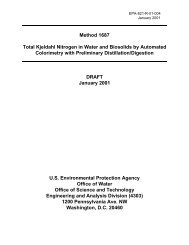Ambient Water Quality Criteria for Bacteria - Water Quality Standards ...
Ambient Water Quality Criteria for Bacteria - Water Quality Standards ...
Ambient Water Quality Criteria for Bacteria - Water Quality Standards ...
You also want an ePaper? Increase the reach of your titles
YUMPU automatically turns print PDFs into web optimized ePapers that Google loves.
11-30-2011<br />
<strong>Ambient</strong> <strong>Water</strong> <strong>Quality</strong><br />
<strong>Criteria</strong> <strong>for</strong> <strong>Bacteria</strong><br />
Objectives, to provide:<br />
An understanding of EPA’s current §304(a) water quality<br />
criteria (WQC) <strong>for</strong> bacteria<br />
In<strong>for</strong>mation regarding the adoption and implementation of the<br />
WQC<br />
An update on EPA’s development of new/revised recreational<br />
WQC
11-30-2011<br />
Why Do We Need <strong>Bacteria</strong><br />
<strong>Criteria</strong>?<br />
<strong>Bacteria</strong> criteria help protect against disease<br />
caused by fecal pathogens from recreational<br />
exposure to contaminated water<br />
37% (1,362) of coastal and Great Lakes<br />
beaches were closed or had an advisory posted<br />
<strong>for</strong> at least one day in 2010<br />
CDC continues to document cases of waterborne<br />
disease outbreaks in their 2011 “Surveillance”<br />
Report (MMWR, CDC 2011)
11-30-2011<br />
Indicators<br />
EPA’s recommended bacteria water<br />
quality criteria (WQC) are <strong>for</strong> indicator<br />
organisms (indicating fecal contamination)<br />
Pathogens are disease-causing<br />
microorganisms that include viruses,<br />
protozoa, and bacteria<br />
Monitoring <strong>for</strong> the many fecal pathogens<br />
is difficult and costly so we monitor <strong>for</strong><br />
fecal indicators instead
11-30-2011<br />
Rec <strong>Criteria</strong> History<br />
Federal bacteria criteria<br />
recommendations first made in 1968<br />
• Based on PHS studies, conducted 1948-1950<br />
Studies measured total coli<strong>for</strong>ms<br />
• Recommended a limit of Fecal coli<strong>for</strong>ms 200<br />
CFUs/100 ml<br />
In 1972 EPA initiated a series of<br />
multiyear, comprehensive epidemiological<br />
studies at marine and fresh water<br />
bathing beaches
11-30-2011<br />
Results of Studies in the<br />
70s/80s<br />
Of the indicators measured during the<br />
studies, E. coli and enterococci showed<br />
strongest correlation to swimmingassociated<br />
gastroenteritis<br />
• E. coli and enterococci in fresh waters<br />
• Enterococci in marine waters<br />
Results described in detail in the 1986<br />
(current) <strong>Bacteria</strong> <strong>Criteria</strong> document
11-30-2011<br />
The Use of EPA’s<br />
Recommended <strong>Criteria</strong><br />
The criteria are used in two different, yet<br />
related ways:<br />
• Protection of water bodies designated <strong>for</strong><br />
recreational uses in state and tribal WQS<br />
Used to derive permit limits, make listing decisions, and<br />
develop TMDLs<br />
• Beach monitoring and notification programs<br />
Protect public health<br />
Aid in determining when to issue advisories or close<br />
beaches
11-30-2011<br />
<strong>Bacteria</strong> <strong>Criteria</strong> in <strong>Water</strong><br />
<strong>Quality</strong> <strong>Standards</strong><br />
States adopt bacteria criteria to protect<br />
waters designated <strong>for</strong> recreation<br />
• Primary contact recreation<br />
Seasonal and intermittent uses<br />
• Secondary contact recreation<br />
States designate the majority of waters<br />
<strong>for</strong> primary contact
11-30-2011<br />
Components of EPA’s <strong>Criteria</strong><br />
E. coli and enterococci criteria have two components:<br />
• Geometric mean<br />
• Single Sample Maximum or Upper Percentile Value<br />
Frequency of Observed Indicator<br />
Densities<br />
Geometric mean:<br />
• Assessing medium<br />
and long term impacts<br />
•WQBELS<br />
Indicator Density<br />
Single sample maximum<br />
•Beach monitoring<br />
75 th percentile<br />
95 th percentile
11-30-2011<br />
Primary Contact Recreation<br />
Current Fresh <strong>Water</strong> <strong>Criteria</strong> Recommendations<br />
• Enterococci<br />
Risk Level<br />
(% of<br />
swimmers)<br />
• E. Coli<br />
Geometric<br />
Mean Density<br />
(per 100 mL)<br />
Single Sample Maximum Allowable Density (per 100 mL)<br />
75 th<br />
percentile<br />
82 nd<br />
percentile<br />
90 th<br />
percentile<br />
95 th<br />
percentile<br />
0.8 33 62 79 107 151<br />
Risk Level<br />
(% of<br />
swimmers)<br />
Geometric<br />
Mean Density<br />
(per 100 mL)<br />
Single Sample Maximum Allowable Density (per 100 mL)<br />
75 th<br />
percentile<br />
82 nd<br />
percentile<br />
90 th<br />
percentile<br />
95 th<br />
percentile<br />
0.8 126 236 299 409 576
11-30-2011<br />
Primary Contact Recreation<br />
Current Marine <strong>Water</strong> <strong>Criteria</strong> - Enterococci<br />
Risk Level<br />
(% of<br />
swimmers)<br />
Geometric<br />
Mean Density<br />
(per 100 mL)<br />
Single Sample Maximum Allowable Density (per 100 mL)<br />
75 th<br />
percentile<br />
82 nd<br />
percentile<br />
90 th<br />
percentile<br />
95 th<br />
percentile<br />
1.9 35 104 158 276 501
11-30-2011<br />
What is the BEACH Act?<br />
2000 Amendment to the Clean <strong>Water</strong> Act, <strong>for</strong><br />
coastal and Great Lakes recreation waters<br />
• Applies to 35 States<br />
Key EPA requirements<br />
• Ensure state adoption of coastal recreation water quality<br />
criteria<br />
• Conduct research on pathogen indicators in coastal<br />
recreation waters and develop rapid methods<br />
• Publish per<strong>for</strong>mance criteria <strong>for</strong> monitoring and notification<br />
• Provide development and implementation grants to state,<br />
tribal and local authorities
11-30-2011<br />
The BEACH ACT Regulation<br />
EPA promulgated on November 16, 2004<br />
Best source of in<strong>for</strong>mation on EPA’s interpretation<br />
of the criteria <strong>for</strong> both coastal recreation waters<br />
and inland waters<br />
Preamble and technical fact sheets include some<br />
implementation language
Risk Levels<br />
11-30-2011<br />
Key Implementation Points:<br />
• EPA data support:<br />
Risk Levels<br />
up to 19 illnesses/1000 swimmers in marine water<br />
up to 10 illnesses/1000 swimmers in freshwater<br />
• Higher illnesses rates <strong>for</strong> protection of<br />
primary contact uses must be supported by<br />
data<br />
• No UAA required to move between risk levels<br />
of 8 – 10 illnesses/1000 swimmers <strong>for</strong> a<br />
freshwater body
11-30-2011<br />
Key Implementation Points:<br />
Geo Mean and SSM<br />
Geometric mean is value most closely linked to<br />
the illness rates<br />
Single Sample Maximum was not intended to be<br />
used as a “not to be exceeded” value
Geo Mean and SSM in<br />
BEACH Act <strong>Water</strong>s<br />
Must have both Geo Mean and SSM <strong>for</strong> all waters<br />
designated <strong>for</strong> primary contact rec<br />
Must use SSM <strong>for</strong> beach closure and advisory<br />
programs<br />
States have flexibility to:<br />
Adopt some or all of the SSMs<br />
Describe the applicability of the SSM <strong>for</strong> the various CWA<br />
purposes in their standards<br />
Do not have situations where neither Geo Mean nor<br />
SSM apply<br />
Federal promulgation does not include minimum sample size<br />
requirements <strong>for</strong> calculating the Geo Mean.
11-30-2011<br />
Geo Mean and SSM in<br />
Inland <strong>Water</strong>s<br />
For ‘inland waters’ (in other words, waters not covered by<br />
the BEACH Act), EPA recommends the same criteria as<br />
required <strong>for</strong> BEACH states under the Beach regulation.<br />
States/tribes with inland waters are encouraged to follow<br />
the same steps as in the previous slide.
11-30-2011<br />
Uses of the SSM<br />
Beach advisory and closure programs<br />
<strong>Water</strong>body assessment<br />
• Small datasets<br />
• When states collect “insufficient” (as defined<br />
by their regs) data to reliably average and<br />
compare to the geometric mean<br />
• Sources of short-term spikes (CSOs)<br />
EPA encourages states to clarify in their water<br />
quality standards how they will use the SSM<br />
component.
11-30-2011<br />
Key Implementation Points:<br />
Non-Human Sources<br />
Non-Human source exclusions to the<br />
criteria can be allowed when:<br />
• The sources are only from non-human<br />
sources (supported by sanitary<br />
surveys/watershed characterization studies)<br />
AND<br />
• Those non-human sources are shown to pose<br />
no risk to human health (i.e., through an epi<br />
study)<br />
States may use existing epi data in lieu of<br />
conducting their own studies
EPA’s New/Revised <strong>Criteria</strong><br />
Objective<br />
Why?<br />
• Beach Act requires new/revised criteria<br />
• Incorporate new science—over 20 years since<br />
1986 criteria; CWA requires updates “from<br />
time to time”<br />
• Improve scientific foundation and<br />
implementation based on what we’ve learned<br />
over the past 20 plus years<br />
• Ease implementation <strong>for</strong> BEACH Act states:<br />
no double standards<br />
• Makes providing protection <strong>for</strong> downstream<br />
rec waters easier<br />
• 2012 is Consent Decree deadline<br />
11-30-2011
Major Research Areas<br />
Epidemiology Studies and Quantitative Microbial<br />
Risk Assessment (QMRA)<br />
Site Characterization<br />
Indicators/Methods Development and Validation<br />
Modeling<br />
Application to:<br />
>Coastal (marine) waters<br />
>Great Lakes<br />
>Inland <strong>Water</strong>s- rivers, streams, lakes<br />
11-30-2011 20
11-30-2011<br />
Revising the Rec <strong>Criteria</strong><br />
BEACH Act also required EPA to publish<br />
new/revised criteria <strong>for</strong> coastal<br />
recreational waters<br />
EPA will release a draft revised Rec<br />
<strong>Criteria</strong> <strong>for</strong> scientific views from the<br />
public in early 2012<br />
The final revised Rec <strong>Criteria</strong> will be<br />
signed no later than October 15 2012.<br />
The revised RWQC will be based on new<br />
epi data to assure protection of public<br />
health
11-30-2011<br />
Expert and Stakeholder Input on<br />
Revised RWQC<br />
March 2007 (Warrenton, VA) – Experts workshop<br />
February 2008 (Washington, D.C.)<br />
• Purpose, content & status of Critical Path Science Plan<br />
February 2009 Inland <strong>Water</strong>s Workshop<br />
October 2009 (Chicago, IL )<br />
• Status update on research<br />
March 2010 (Webinar) – recap of October 2009 meeting<br />
October 2010 (Webinar)<br />
• Framing main issues associated with the new criteria<br />
June 2011 (New Orleans, LA)<br />
• Input on evaluation and synthesis of research and development of<br />
options <strong>for</strong> structure of the new criteria<br />
September 2011 (Webinar) - recap of the June meeting<br />
September 2011 (Washington) – Scientific Peer Review<br />
November 2011 (Atlanta, GA) Expert Workshop on wildlife (non-human)<br />
sources of fecal contamination
Current Thinking on the Draft<br />
RWQC<br />
Recommend 304(a) criteria that apply to all waters<br />
(not just the BEACH states, territories and tribes)<br />
• Encourages consistency, as waters flow between<br />
states<br />
Derive criteria based on the NEEAR research at<br />
POTW-impacted sites<br />
• Consistent with 1986 criteria values<br />
• Aim to carry <strong>for</strong>ward into new criteria level of water quality<br />
protection af<strong>for</strong>ded by current criteria recommendations<br />
Allow <strong>for</strong> all states to take advantage of the newer<br />
science, <strong>for</strong> example: qPCR tool and predictive<br />
modeling
Current Thinking on the Draft<br />
RWQC (2)<br />
Recommend culture methods <strong>for</strong> Enterococcus and E.coli in<br />
freshwaters, and Enteroccocus in marine waters<br />
Clarify the expression of criteria construct<br />
• Maintain Geometric Mean and something akin to SSM (STV)<br />
• Eliminate “use intensity” risk range<br />
Provide tools <strong>for</strong> site-specific criteria derivation (QMRA with<br />
sanitary survey) and other flexibilities<br />
11-30-2011<br />
• Science does not permit us to recommend different,<br />
nationally applicable criteria values <strong>for</strong> different sources<br />
(e.g., gulls).<br />
• Predictive models as tool to enhance implementation of<br />
criteria, particularly <strong>for</strong> beach programs
Current Thinking on the Draft<br />
RWQC (3)<br />
Provide tools <strong>for</strong> rapid analysis<br />
11-30-2011<br />
• Enteroccocus qPCR method in freshwater and marine waters<br />
<strong>for</strong> beach closure notification. Faster approach to<br />
measuring fecal indicator bacteria<br />
• Predictive modeling
For More In<strong>for</strong>mation<br />
EPA’s Beach and Rec <strong>Criteria</strong> Web Pages<br />
• http://water.epa.gov/type/oceb/beaches/index.cfm<br />
BEACH Act text<br />
Grants in<strong>for</strong>mation<br />
Beach Guidance Document<br />
Local beach in<strong>for</strong>mation<br />
• http://water.epa.gov/lawsregs/lawsguidance/beachrules/bacteriarule.cfm<br />
BEACH Act rule<br />
Technical fact sheets<br />
• http://water.epa.gov/scitech/swguidance/standards/criteria/health/r<br />
ecreation/index.cfm<br />
Experts Scientific Workshop Report and Executive Summary<br />
Critical Path Science Plan<br />
Consent Decree & Settlement Agreement Documents<br />
Stakeholder Meeting/Workshop agendas and summaries<br />
Research Reports completed in 2010<br />
Tracy Bone<br />
• 202-564-5257 or bone.tracy@epa.gov<br />
26
Take Home Messages<br />
EPA’s current §304(a) bacteria criteria are<br />
<strong>for</strong> E. coli and enterococci<br />
When using the ’86 bacteria criteria, states<br />
and tribes have flexibility;<br />
• To make appropriate risk-based decisions<br />
• In using the single sample maximum component<br />
of the criteria<br />
EPA is developing new/revised criteria <strong>for</strong><br />
publication in 2012



